Gillig Phantom
| Gillig Phantom | |
|---|---|
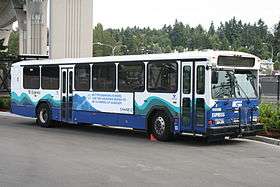 2008 Phantom operated by Sound Transit; one of the final examples built. | |
| Overview | |
| Type | Bus |
| Manufacturer | Gillig Corporation |
| Production | 1980-2008 |
| Assembly | United States: Hayward, California |
| Body and chassis | |
| Class | |
| Doors |
1 door (school bus) 2 door |
| Floor type | High floor, step entrance |
| Chassis | Gillig |
| Powertrain | |
| Engine |
Caterpillar Cummins Detroit Diesel |
| Capacity | 78-84 passengers (school bus configuration) |
| Dimensions | |
| Length | 30–40 ft (9.1–12.2 m) |
| Width | 96–102 in (2,438–2,591 mm) |
| Chronology | |
| Predecessor | Gillig Transit Coach |
| Successor | Gillig Low Floor |
The Gillig Phantom is a bus that was produced by American manufacturer Gillig Corporation in Hayward, California. The successor to the long-running Gillig Transit Coach model line, the Phantom marked the transition of Gillig from a producer of yellow school buses to that of transit buses.
The first transit bus assembled entirely by Gillig (the company assembled a few vehicles with Neoplan from 1977 to 1979), the Phantom was produced exclusively as a high-floor bus (with step entrance). Three primary configurations of the Gillig Phantom were produced. Alongside the standard transit bus, a suburban version was offered (fitted with forward-facing seats), and a Gillig Phantom School Bus (adapted for school bus use).
Following the shift towards low-entry buses in North America, the Gillig Phantom gradually became superseded by the Gillig H2000LF/Low Floor. Initially produced alongside the Low Floor, in 2008, Gillig ended production of the Phantom to concentrate entirely on low-floor buses. Production of the Phantom ended in September 2008, with some of the last examples purchased by Sound Transit.
Model overview
When introduced in 1980, the Gillig Phantom was offered in a single configuration, with a 96-inch width and a 35-foot length. For 1981, additional 30-foot and 40-foot lengths were introduced, with a 102-inch body width introduced in 1983. From 2005 onward, only the 102-inch-wide version was available due to stricter emissions and accessibility requirements.
With the exception of the Phantom School Bus, the Gillig Phantom was produced with a front entrance door and a mid-ship exit door. With the latter, two widths were available, with most transit customers opting for the narrower version (with the wider version often sold to airport shuttle operators and rental car agencies). A wheelchair lift (integrated into the step entrance) was available as an option for either entrance; if ordered for the rear door, the wider rear door was configured. On suburban configurations (with forward-facing seats), the Phantom was also offered with onboard luggage racks (typically mounted above the seats).
While a mandatory feature on the Phantom School Bus, a rear window was a rare option for transit/suburban Phantoms; Monterey-Salinas Transit and King County Metro are the only two transit authorities known to have ordered Phantoms with a rear window. On transit/suburban versions, several window configurations were offered; fixed side windows were a rarely ordered option.
During its production, the exterior of the Gillig Phantom saw little change, with the exception of modernization of its destination sign. The Phantom was offered with either dual headlights or quad headlights, with the quad-headlight version becoming the most common (the Phantom School Bus was primarily configured with dual headlights).
- 1980-2008 Gillig Phantom, transit/suburban buses
 1985 Gillig Phantom of LADOT (Los Angeles, California)
1985 Gillig Phantom of LADOT (Los Angeles, California)- 1991 Gillig Phantom of Northern Illinois University (DeKalb, Illinois)
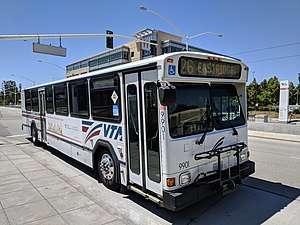 1999 Gillig Phantom of Santa Clara Valley Transportation Authority (Sunnyvale, California)
1999 Gillig Phantom of Santa Clara Valley Transportation Authority (Sunnyvale, California) Interior view, 1999 Gillig Phantom of Santa Clara Valley Transportation Authority (Sunnyvale, California)
Interior view, 1999 Gillig Phantom of Santa Clara Valley Transportation Authority (Sunnyvale, California)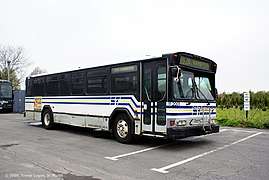 2001 Gillig Phantom (suburban configuration) of Suffolk County Transit (Long Island, New York)
2001 Gillig Phantom (suburban configuration) of Suffolk County Transit (Long Island, New York)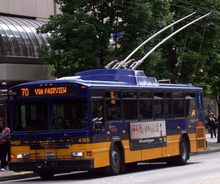 2001-2003 Gillig Phantom trolleybus of King County Metro (Seattle, Washington)
2001-2003 Gillig Phantom trolleybus of King County Metro (Seattle, Washington)
Gillig Phantom School Bus
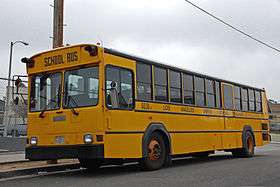
In 1986, Gillig introduced a school bus variant of the Phantom; the successor to the Transit Coach, the Phantom School Bus was the first all-new school bus from Gillig in 42 years. Although well received by its operators, sales dropped off in the late 1980s, leading to its discontinuation in 1993 (no Phantom school buses were sold in 1991 or 1992).
Aside from the obvious school bus yellow color scheme and warning lights, Phantom school buses were distinguished from the standard Phantom by several exterior design features. As it was the maximum approved width at the time for the type, all Phantom school buses were constructed with the 96-inch wide body. Additionally, they were equipped with dual vertical windshields, a rear (emergency exit) window, left-side emergency exit door, and single curbside door.
Powertrain
The Phantom was originally equipped with either a Detroit Diesel 6V92TA, 6V71, or Cummins L-10 diesel engine, and was later available with either a Cummins ISB, ISC, ISL, or ISM diesel engine. The Phantom was formerly available with the Detroit Diesel Series 50 engine from 1993 until 2004 when Detroit Diesel cut production of the Series 50 engine. The Detroit Diesel Series 40 engine was available from 1995 to 2003.
A liquefied natural gas fueled version was produced beginning in 1992; it was later discontinued. A diesel-electric hybrid powered version was sold from 1996 to 2006; MTA in New York purchased a Gillig Phantom hybrid demo bus as well as diesels for MTA Long Island bus. From 2001 to 2003, King County Metro purchased 100 Gillig Phantoms to convert to trolleybuses. Purchased as "gliders" with no powertrain, the buses were fitted with the trolleybus propulsion system from its previous fleet, saving over $20 million from an all-new design.
| Engine Manufacturer | Engine Model | Years Available | Notes |
|---|---|---|---|
| Caterpillar | 3208
C9 |
3208: 1986-1990
C9: 2003-2008 |
3208 available almost exclusively in Phantom school buses.
Only 57 transit buses were specified with this engine, all of which went to Ride On in Montgomery County, Maryland and delivered in 1989; all were 30 feet long. |
| Cummins | L-10 ISB C8.3,ISC ISL ISM M11 |
L10: 1984-1994
ISB: 1997-2008 C8.3: 1993-1998 ISC: 1998.5-2006 ISL: 2001-2008 M11: 1994-1998 ISM: 1999-2008 |
|
| Detroit Diesel | 6V71,6V71TA 6V92TA Series 40 Series 50 |
6V71/6V71TA: 1980-1988
6V92TA: 1980-1994 Series 50: 1993-2004 Series 40: 1995-2003 |
The Detroit Diesel 6V71 engine was available only for 30' buses while the 6V71TA was available for 30' and 35' models. |
See also
References
Further reading
- Gillig Corporation, gillig.com, Retrieved on 2006-12-25
- Gillig Phantom gillig.com, Retrieved on 2010-02-02
- Gillig Transit Coach / Pacific SchoolCoach Online Museum, gilligcoaches.net, Retrieved on 2006-12-25
- GM Brings Clean Mass Transit to Environmental Conference, allisontransmission.com, Retrieved on 2006-12-25
- Stauss, Ed (1988). The Bus World Encyclopedia of Buses, Woodland Hills, CA: Stauss Publications. ISBN 0-9619830-0-0
External links
| Wikimedia Commons has media related to Gillig Phantom. |